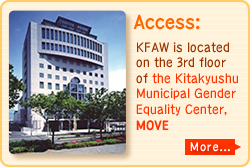On February 2, 2013, the World Report was held focusing on “Multicultural Coexistence in Japan, Korea, and the U.S.” at the Kitakyushu Municipal Gender Equality Center, MOVE.

In Incheon Metropolitan City, a wide variety of NPOs and NGOs are promoting activities regarding multicultural coexistence, leading the general public to greater awareness of the issue. People are seriously faced with problems inflicted on migrant women after their international marriages. Mr. KIM concluded his address by indicating that in order to make society even better, it is important to create a society where people with different cultures can live in harmony, and to involve many citizens.
 President Kim’s address was followed by a report by Ms. Kay Makishi, Coordinator of International Relations at the Japan Exchange and Teaching (JET) Program, on “Multicultural Coexistence and Women’s Participation in Society in the U.S.” The U.S. society was once characterized by the concept of the “melting pot” (in which minority groups abandon their own cultures and languages and merge into the majority group). Now, the focus has been shifted from there to the concept of the “salad bowl” (in which minority groups ensure coexistence, while respecting their own cultures and languages.) This has transcended the boundaries of just racial and ethnic categories, forming society in which diversity is ensured for a wide range of minority groups, including gays, the disabled, and sexual minority groups.
President Kim’s address was followed by a report by Ms. Kay Makishi, Coordinator of International Relations at the Japan Exchange and Teaching (JET) Program, on “Multicultural Coexistence and Women’s Participation in Society in the U.S.” The U.S. society was once characterized by the concept of the “melting pot” (in which minority groups abandon their own cultures and languages and merge into the majority group). Now, the focus has been shifted from there to the concept of the “salad bowl” (in which minority groups ensure coexistence, while respecting their own cultures and languages.) This has transcended the boundaries of just racial and ethnic categories, forming society in which diversity is ensured for a wide range of minority groups, including gays, the disabled, and sexual minority groups.
As one of the efforts toward the realization of multicultural coexistence, she introduced the U.S. educational system. Differences in comparison with the Japanese educational system include 1) emphasis on understanding different cultures; 2) assessment of students from general aspects, including music, club, and volunteer activities, rather than based only on examination results and academic performance; and 3) demand for students to express their own opinions appropriately. It is thought that this type of educational system helps build the foundation for people to accept those different from themselves. As a result of raised awareness of the contribution that diversity makes to society, people learn to accept it.
 Afterwards, Associate Professor Yuriko Saito of Meiji Gakuin University presented a report with the theme of “Multicultural Coexistence in Japan – Focus on Women and Children.” Japanese policies regarding multicultural coexistence have so far been mainly about the administrative aspects of foreign residents in Japan. Multicultural coexistence policies have been promoted under the leadership of local municipalities where there are many foreign permanent residents (such as Toyota City of Aichi Prefecture, Oizumi Town of Gunma Prefecture, and Minokamo City of Gifu Prefecture). Ms. Saito indicated that in this age of competition, becoming further intensified by globalization, it is necessary to improve policies on the national government level to take care of various challenges, such as the birth rate decline and the aging population, as well as the future labor shortage.
Afterwards, Associate Professor Yuriko Saito of Meiji Gakuin University presented a report with the theme of “Multicultural Coexistence in Japan – Focus on Women and Children.” Japanese policies regarding multicultural coexistence have so far been mainly about the administrative aspects of foreign residents in Japan. Multicultural coexistence policies have been promoted under the leadership of local municipalities where there are many foreign permanent residents (such as Toyota City of Aichi Prefecture, Oizumi Town of Gunma Prefecture, and Minokamo City of Gifu Prefecture). Ms. Saito indicated that in this age of competition, becoming further intensified by globalization, it is necessary to improve policies on the national government level to take care of various challenges, such as the birth rate decline and the aging population, as well as the future labor shortage.
She also mentioned Kitakyushu City’s advantageous characteristics, such as its geographical proximity to Asian countries and its being home to international organizations, such as KFAW, JICA, and UN Women. She raised a question of whether, despite the coexistence of many foreign people, multicultural human resources are fully utilized in the city. She concluded her report by proposing that multicultural coexistence does not mean support (service) for foreign people, but living together, and that it will be necessary in the future international society to emphasize establishing a society where people can express their opinions without any hesitation by providing opportunities for people to discuss various issues.
 The subsequent panel discussion was coordinated by Associate Professor Saito. The discussion further explored what had been presented by each panelist and examined what was common to the countries concerned, and what should be learned from each other. A Q&A session featured active exchange of opinions, enabling all the participants to share future challenges and problems.
The subsequent panel discussion was coordinated by Associate Professor Saito. The discussion further explored what had been presented by each panelist and examined what was common to the countries concerned, and what should be learned from each other. A Q&A session featured active exchange of opinions, enabling all the participants to share future challenges and problems.
◆The handouts (Japanese only) provided on the day of the event are available as follows:


